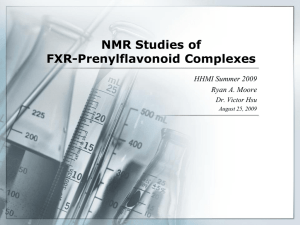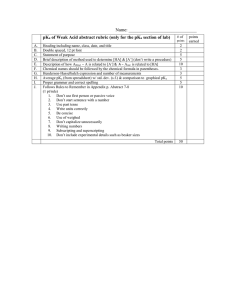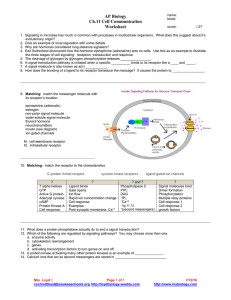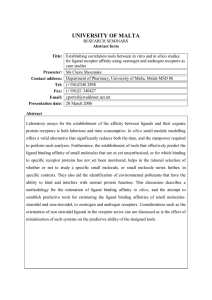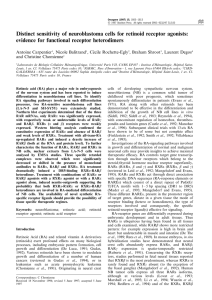High cholesterol intake leads to reduced cholesterol
advertisement
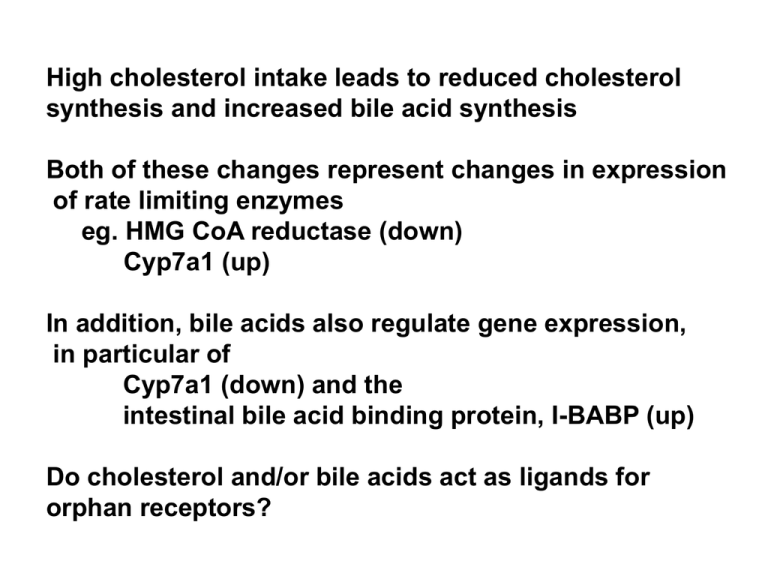
High cholesterol intake leads to reduced cholesterol synthesis and increased bile acid synthesis Both of these changes represent changes in expression of rate limiting enzymes eg. HMG CoA reductase (down) Cyp7a1 (up) In addition, bile acids also regulate gene expression, in particular of Cyp7a1 (down) and the intestinal bile acid binding protein, I-BABP (up) Do cholesterol and/or bile acids act as ligands for orphan receptors? The orphan receptor, FXR is activated by bile acids Ligand: chenodeoxycholic acid (CDCA, a primary bile acid) FXR expression pattern makes sense Bile Acids regulate endogenous gene expression a) immunoblot of Cyp7a1 b) RT-PCR of cyp7a1 mRNA Cyp7a1 I-BABP Small lipophilic molecule Nuclear Receptor Responsive genes: major phenotypic response - homeostatic response cytochrome P450 enzymes (CYP x) Transporters (ABCs) Cellular binding proteins Receptor LXR FXR PPAR RAR Ligand oxysterols bile acids fibrates fatty acids retinoic acid SXR/PXR steroids/ xenobiotics CYP ABC transporter CYP7A1 CYP7A1 CYP4A1 CYP4A3 CYP26A1 ABCA1 etc. ABCB11 ABCB4 CYP3A CYP2C ABCB1, C2 ? A sampling of ligands for PXR: Although SXR/PXR ligand specificity is loose (very), it is also species specific. For example: PCN activates mPXR not hPXR Rifampcin activates hPXR(SXR) but not mPXR. This becomes problematic when studying pharmokinetics and drug-drug interactions using rodent models Possible solution: make a “humanized” mouse Mouse-mouse Humanized-mouse Non-traditional functions of nuclear receptors: •Trans-repression •Non-genomic actions TRANS-REPRESSION Signal X Factor X (eg. NFkB, AP-1) Target Gene NHR + Ligand Transcription Factors recruit large, multi-protein co-activator complexes to specific sites on chromatin Co-activators are seemingly non-discriminatory CBP/p300 Trans-repression might result from competition for limiting amounts of co-activators: TFIID RE Pol II TATA Co-Act NFkB TFIID RE TATA Pol II If trans-repression results from competition for limiting co-activator, then adding more should relieve repression: X: H: Co-A: - + - + + - + + + But GR trans-repression of IL6 promoter not reversed De Bosscher et al PNAS 97:3919,2000 …and trans-repression is promoter specific NI : no inducer D = dexamethasone T = TPA IL6kB-luc De Bosscher et al PNAS 97:3919,2000 pNFkB-luc Trans-repression---is it real? Best evidence for: GRDim/GRDim mice have point mutation preventing dimerization and DNA binding: Mutant mice are viable (GR-/GR- mutants are not!) No evidence of transactivation or of active repression (via nGRE in promoter of POMC or prolactin genes) Non-genomic functions Some ligands have actions that are not dependent on transcriptional regulation: Examples: •Progesterone induced maturation of oocytes •Estrogen activation of: G-proteins/ Calcium channels / NO synthesis cAMP and cGMP synthesis / K channels PKC, PKA, PI3K/PKB, ERK, p38, IGF-1R… and so on. •Many of these events occur within seconds to minutes •Many occur in the presence of actinomycin D and/or cycloheximide (i.e. in the absence of RNA or protein synthesis!) •Many can be induced using BSA-E2 conjugates (i.e. forms of E2 that can not enter cells!!) •Therefore, there has to be additional receptors, additional functions for the known receptors, or both The Progesterone Receptor mediates hormone-induced oocyte maturation The Progesterone Receptor mediates hormone-induced oocyte maturation - I Open bars: H2O Filled bars: XPR-1 mRNA The Progesterone Receptor mediates hormone-induced oocyte maturation - II A2 = antisense oligos PKI = inhibitor of PKA The Progesterone Receptor mediates hormone-induced oocyte maturation - III Control Antisense + xPR hPR Antisense Cytoplasmic estrogen receptor-a, physically interacts with components of kinase signaling cascades E2:ERa activates IGF-1R (IGF-1R) E2 induces physical interactions between ERa and IGF-1R Phosphorylation regulates receptor function Relevant kinases include: PKA, PKC, ERK, JNK Phosphorylation directly: Modulates ligand-dependent activation (PKA and RARa in F9 cells, ERK and PPARg in adipocytes) Is required for function (TFIIH and RARg / RARa in F9 cells) Activates receptors in the absence of ligand (ERK and ER, PKA and PR) Phosphorylation (continued) Limits duration of ligand activation (TFIIH and RARg and the proteosome, PKC and RARa and RXR dimerization) Phosphorylation indirectly: Alters subcellular localization (PKA and RARa in Sertoli cells) Inhibits receptor function (RARa/g and ERKs) PKB/Akt Can Activate ERa PKB/Akt Activates the AF1 Domain of ERa
